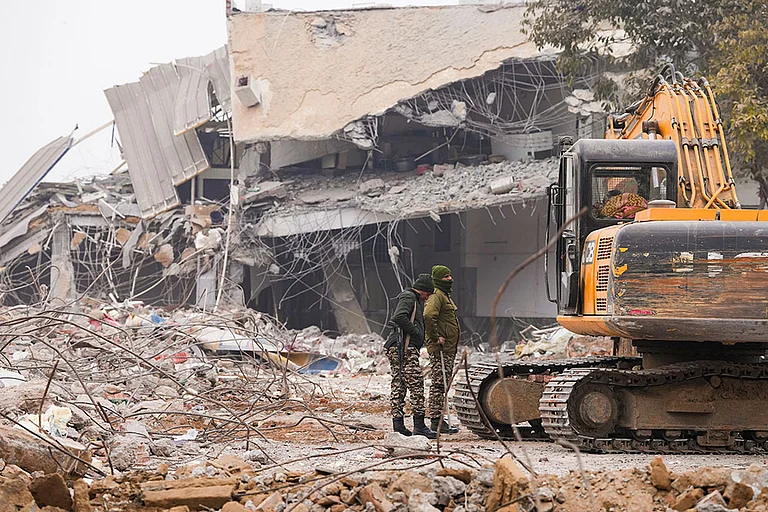It’s a stultifying summer day. As the sun cracks the eastern horizon, it blazes like an ‘atom bomb. Frank May, an American aid worker, is bracing for the sweltering heat after the district-wide blackout in a town in Uttar Pradesh. Sweat drips into his eyes, stinging them: ‘Everything is tan and beige and a brilliant, unbearable white’. Cutting through the air are wails of dismay, and sirens. Cries of distress ricochet off buildings. People are clustered on rooftops and doorways, ‘round-eyed with distress and fear, red-eyed from the heat and exhaust smoke, dust’. Brown faces are flushed red with heat. Metal surfaces in the sun scorch. Heatwaves bounce over them like ‘air over a barbecue.’ This is how American science fiction writer Kim Stanley Robinson opens his novel, The Ministry for the Future (2020), which figured on the list of Barack Obama’s favourite books of the year.
When the mercury soared and a heatwave swept across India in April, Robinson’s novel, set in the near future, made one feel that the summertime suffering described in it was already upon us. Climate experts in the US have found the novel to be eerily prescient as heatwaves continue to sweep through north India, with the mercury soaring to 49 degrees Celsius on Sunday. Robinson imagines how climate change will affect us through fictional eyewitness accounts. In the novel, the high demand for air conditions causes prolonged power outages. It means that only those with generators can afford to keep vaguely cool while a large swathe of the populace succumbs to the extreme weather. Frank May, eventually, becomes a witness to millions of deaths due to excessive heat, and the trauma of a nation struggling to protect its citizens from its relentless ferocity.
The Ministry for the Future is one of the many works in the genre of climate fiction or cli-fi that the last two decades have spawned. The term cli-fi was invented by the US freelance writer Dan Bloom in 2011 to describe Jim Laughter’s novel, Polar City Red, which portrays the lives of climate refugees in a future Alaska. Over a decade before this coinage for the sub-genre of speculative fiction, a group of geologists, led by Nobel Prize-winning Dutch meteorologist and atmospheric chemist Paul Crutzen, started arguing that the present period of earth’s history should be known as the Anthropocene; an era defined by human pressure on the planet, which has a great impact on earth’s geology, ecosystems and biodiversity.

Robinson’s novel, like others in the genre, presages the future, but it also depicts the present reality of our warming world and the climactic upheaval wrought by it. The 563-page novel by the best-known sci-fi writer, who has also written a trilogy woven around the establishment of human civilization on Mars, shows that the chaos caused by carbon is real and we are only a few steps away from extinction. It could very well have been written by an Indian writer. But climate change is a subject that is yet to catch the fancy of fiction writers here. Your search for cli-fi novels written in Indian languages, for instance, is unlikely to yield any result.
In some works in vernacular languages, there are cursory mentions of the weather, hot and cold. There are descriptions of floods and topographical sketches. In this context, some writers from mountain regions, like Vidyasagar Nautiyal, Virendra Jain and SR Harnot, come to mind. But there is hardly any work of fiction one can think of that highlights the climate crisis with its grave, telltale markers: deforestation, droughts, wildfires, and rising temperatures. In 2016, Amitav Ghosh, who had a dwelt on ecology in his novels like The Glass Palace (2000) and The Hungry Tide (2004) lamented this lacuna in fiction writing. In The Great Derangement: Climate Change and the Unthinkable, which was published in that year, he highlighted the consequences of global heating and argued that modern fiction must address the existential threats it posed to humanity. Ghosh, in a way, seemed to echo British environmental writer Robert Macfarlane’s plaintive query in a piece published in The Guardian in 2005: “Where is the literature on climate change?”
In the years that followed, most US and UK writers turned to write about nature and the environment with a vengeance. In 2006, American writer Cormac McCarthy published his post-apocalyptic The Road, which has acquired the status of a cult novel. “Our planet is getting mad as hell and it isn’t going to take it any longer. It’s an old theme but a rich one, and in the 1950s and 60s provided plots for dozens of science-fiction disaster novels. Cities were drowned, oceans eradicated and pastures killed off as authors such as JG Ballard, Charles Eric Maine and John Christopher subjected civilisation to a welter of different indignities – apocalyptic literature that mirrored the era’s cold war uncertainties. Today, in these more strained ecological times, this kind of storytelling has taken on a harder edge and eco-thrillers have become a more robust genre,” wrote Robin McKie, science editor for The Observer, in a review of four books — Sarah Moss’s Cold Earth, Matthew Glass’s Ultimatum, Liz Jensen’s The Rapture, and Stephen Baxter’s Flood — in The Guardian.

To Crutzen and his fellow geologists who started campaigning to term the ongoing phase of history as the Anthropocene from 2000, it is human activity around the globe that altered the history of the earth and resulted in the emission of greenhouse gases, increasing atmospheric levels of carbon dioxide by 30 per cent and methane by 100 per cent. As environmental degradation worsened around the world, both literary and middle-brow writers — T.C. Boyle, Margaret Atwood, Jonathan Franzen, Maggie Gee, Will Self, Jeanette Winterson, Ursula LeGuin and many others — made it a preoccupation in many of their novels. Before greenhouse emissions attracted wide scientific interest, human-altered climates were of grave concern to writers archiving climate change in their fiction, independent US scholar Adam Trexler points out in Anthropocene Fictions: The Novel in a Time of Climate Change (2015), arguably the first systemic examination of climate fiction.
In science fiction, terraforming or the transformation of a planet’s climate in order to make it more hospitable to humans, had surfaced in Arthur C. Clarke’s The Sands of Mars (1951), which is widely seen as the prelude to his emergence as the world’s foremost writer of science fiction novels, and Frank Herbert’s Dune (1965), which reflects on the future of technology and mankind. LeGuin’s 1971 novel, The Lathe of Heaven, in which the future of humanity hinges on a man’s dreams, was the first novel directly concerned with an anthropogenic greenhouse effect.
Climate fiction flourished during the first decade of the 2000s, but the 1990s had already seen its steady expansion. Two speculative novels by major writers in this period include Octavia Butler’s groundbreaking Parable of The Sower and Ben Bova’s Empire Builders, both published in 1993. Besides being a searing commentary on climate change, Butler’s tenth novel, which opens in Los Angeles in 2024, is a meditation on social inequality. At the turn of the millennium, some major literary voices entered the terrain: Kim Stanley’s Robinson’s Antarctica (1999), T.C. Boyle’s A Friend of the Earth and Doris Lessing’s Mara and Dann: the last two were published in 2000.
While politicians have indulged in disinformation and denialism, fiction writers have turned their gaze to the state of the planet in their stories about wildfires and melting Arctic ice and cyclones. Two years after Ghosh’s The Great Derangement, extreme climate events made headlines: flooding in India, raging wildfires in California, and a rapid succession of brutal hurricanes, which claimed several lives. 2018 was also the year when Richard Powers published his 12th novel, the climate-themed epic The Overstory, which won the 2019 Pulitzer for Fiction. The novel, hailed by environmentalists around the world, underlines: Humans are mere underbrush, and the real protagonists in the history of the earth are trees. Some cli-fi novels that stood out for me in the first decade of the 21st century include Maggie O’Farrell’s Instructions for a Heatwave (2013); Rachel Cusk’s Outline and Samanta Schweblin’s Fever Dream (both published in 2014); and Annie Proulx’s Barkskins (2016). American writer Alexandra Kleeman’s Something New Under the Sun, which was published last year, is a beautiful exploration of the environmental catastrophe in the post-truth age of alternative facts.
According to Trexler, the novel has become an essential tool to construct meaning in the age of climate change. Not only does it expand the reach of climate science beyond the laboratory, it also turns abstract predictions into ‘tangible experiences of place, identity, and culture’. While political and economic organisations get transformed by their struggle for sustainability, the novel, too, is compelled to adapt to new boundaries between truth and fabrication, individual choice and larger systems of natural phenomena. Robinson’s novel does this rather well: it flits between the real and the imagined to show that the future is upon us.


























